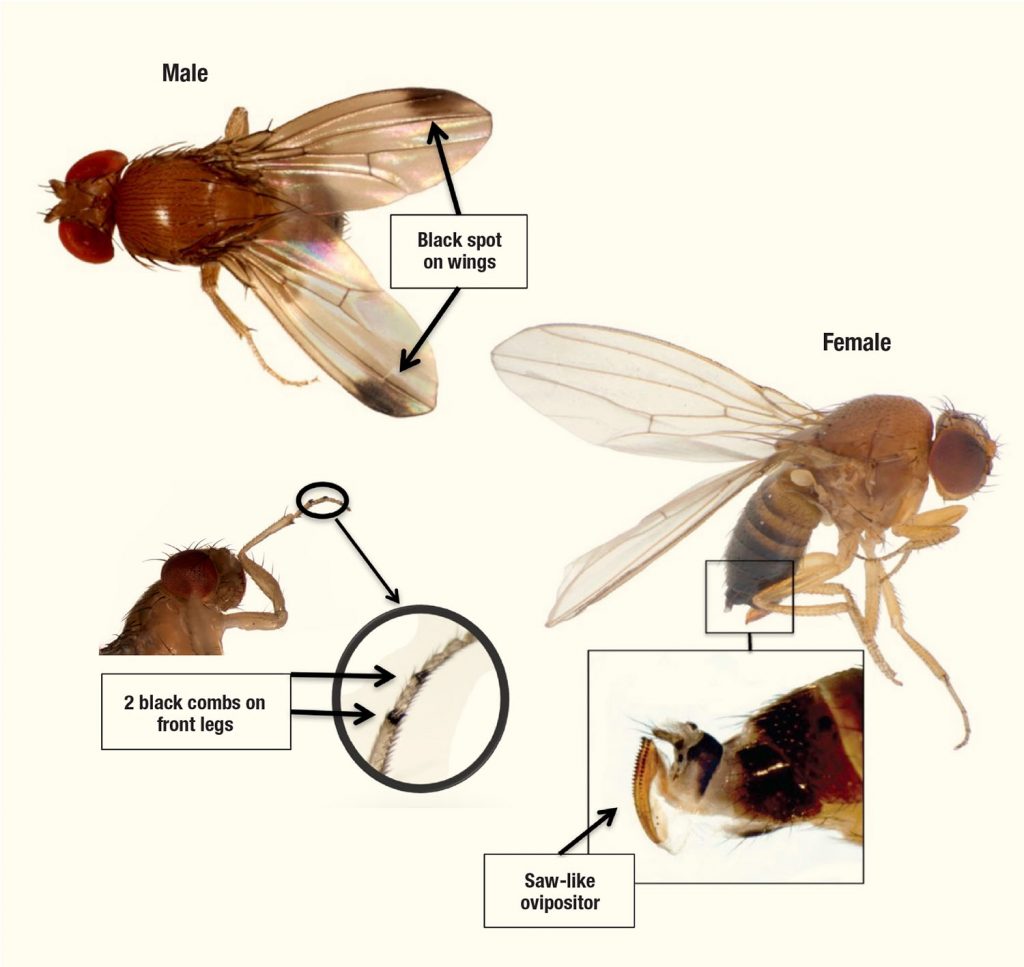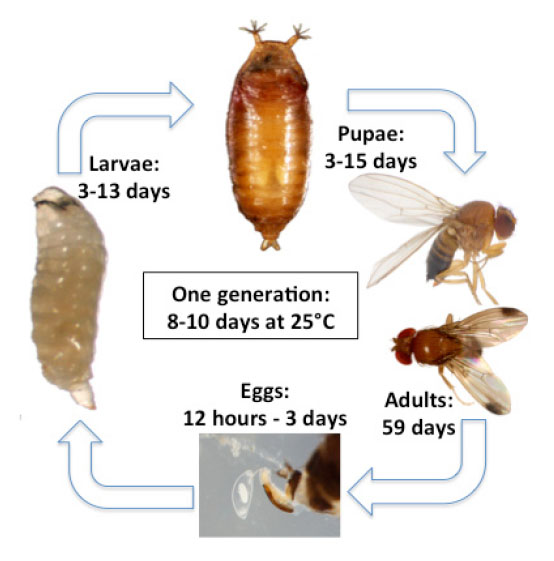
By Ashfaq Sial
Since its first detection in 2008, spotted-wing drosophila (SWD) has emerged as a devastating pest of berry and cherry crops throughout the United States.
IDENTIFICATION AND DEVELOPMENT
Male SWD have dark spots on the outer margins of their wings. Female SWD have saw-like ovipositors used to cut the skin of ripe or ripening fruit and deposit eggs inside the fruit (Figure 1).

Larvae feed inside the berries and develop through three stages within the fruit, causing it to degrade (Figure 2). Larger larvae are visible to the naked eye, and if they are detected in the fruit, distributors may reject contaminated loads of fruit. SWD injury also increases the risk of damage by other pests and fungal infections.
In regions with mild winter climates (e.g., Georgia, Florida and California), SWD adults can be captured in traps year-round and can infest ripe fruit. Females lay over 300 eggs that develop to adult flies in eight to 10 days during the growing season, completing several generations per year (Figure 3). High populations build up over a short period of time. A wide host range, fast generation time, ability to lay eggs directly into the fruit, and larvae being sheltered from insecticide applications while feeding inside the fruit make this pest a challenge to manage.

CONTROL COMPONENTS
A multi-regional team of researchers I lead has investigated behavioral, cultural, biological and chemical strategies to effectively control SWD. This team was funded by the U.S. Department of Agriculture National Institute of Food and Agriculture through the Organic Agriculture Research and Extension Initiative (Project # 2015-51300-24154 and 2018-51300-28434). Based on the team’s findings, SWD control programs should consist of three major components: 1) monitoring and identification, 2) preventative tactics such as exclusion, sanitation, frequent harvest intervals, pruning, mulching and resistant varieties and 3) curative tactics such as the judicious use of insecticides.
While a number of insecticides provide good SWD control in conventional production systems, organic management of SWD is really challenging. However, the research team developed a list of National Organic Program-approved insecticides that can be used to control SWD. Although insecticides are typically needed to maintain fruit quality on commercial farms, organic growers should integrate cultural, physical, behavioral and biological tactics into their SWD management programs as much as possible to help ensure effective control and prevent insecticide resistance development.
10 TIPS
Based on research findings, implementation of the following strategies is recommended to effectively control SWD and protect fruit.
- Planting regionally appropriate early-ripening varieties and varieties with thicker-skinned fruit can help decrease the chances of SWD infestation.
- SWD adults are very sensitive to desiccation (drying out) and do not perform well at high temperatures and low humidity. Heavy pruning of blueberries will allow more light to penetrate through the canopy, which may lower humidity and increase temperature leading to less SWD infestation.
- SWD larvae often emerge from fruit to pupate in a suitable protected place, usually under the soil surface. Using black plastic weed mat as mulch on the ground provides an effective barrier that prevents larvae from pupating underneath the soil surface, reducing SWD survival in the field.
- Physically excluding SWD from the crop is very effective in preventing SWD infestation. Timely installation of insect netting to high tunnel infrastructure (side walls and ends of tunnels) provides a physical barrier to SWD.
- Over-ripe and damaged fruit act as a reservoir for SWD and other pests in the field. Do not leave waste piles of fruit in the open. They should be bagged, burned or frozen. If bagging the fruit, use a clear trash bag and leave it in the sun for at least 48 hours to kill the larvae.
- SWD has a broad host range and will infest other non-crop plants, especially those that produce small fruits. A list of plants that can serve as SWD hosts is available at https://bit.ly/2JeVDwd. If these alternate plant hosts are present on the edge of the field, removing them could decrease the onset and severity of the SWD infestation.
- Ripe berries serve as a strong attractant for SWD. Frequent harvesting of the ripe fruit will decrease risk of SWD infestation in the fruit.
- Once SWD is detected in traps, insecticide applications need to be made to protect fruit from SWD infestation. Conventional management programs rely on the frequent use of pyrethroid, spinosyn, organophosphate, carbamate or diamide insecticides. Of these chemical classes, only the spinosyn insecticide spinosad is approved for use in organic systems. This means that other non-chemical control measures must be implemented to control SWD in organic berries. Among the organic insecticides, Entrust (spinosad) is the most effective but must be rotated with other insecticides to decrease resistance development and meet current label requirements. Products that can be used in a rotation program with Entrust include Pyganic, Grandevo, Venerate and Azera. Agricultural sanitizers such as Jet-Ag and OxiDate 2.0 used in tank-mix or rotation with insecticides also show some promise for use in organic integrated pest management programs.
- Spray coverage and timing of applications are critical to achieving good control. Sprayers should be calibrated at least annually, and appropriate spray volumes used to achieve excellent coverage. Initial research suggests that SWD are more active in the field during cooler parts of the day, in the morning and at dusk. Targeting sprays during these times may increase efficacy. When bees are present in the crop, avoid insecticide applications. If control is needed, use insecticides less toxic to bees and do not spray when they are active.
- After harvest, cool fruit as soon as possible to maintain quality. Cooling the fruit to 35°F for three days has been shown to kill SWD larvae. If fruit is sold directly to consumers, advise them to keep it in the refrigerator. Freezing the fruit will kill eggs and larvae of SWD.
SUMMARY POINTS
In a nutshell, controlling SWD requires a rigorous, persistent and diverse management plan. Using as many control techniques as possible will help to reduce SWD infestation. Continue to evaluate your management program by monitoring SWD populations. Sample ripe and ripening fruit regularly to determine whether your management program is working and respond in a timely manner if needed. Always stay informed of your regional SWD pressure and new management techniques by contacting your local research and Extension personnel and utilizing the resources recommended by them.









